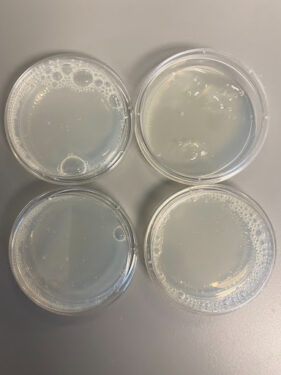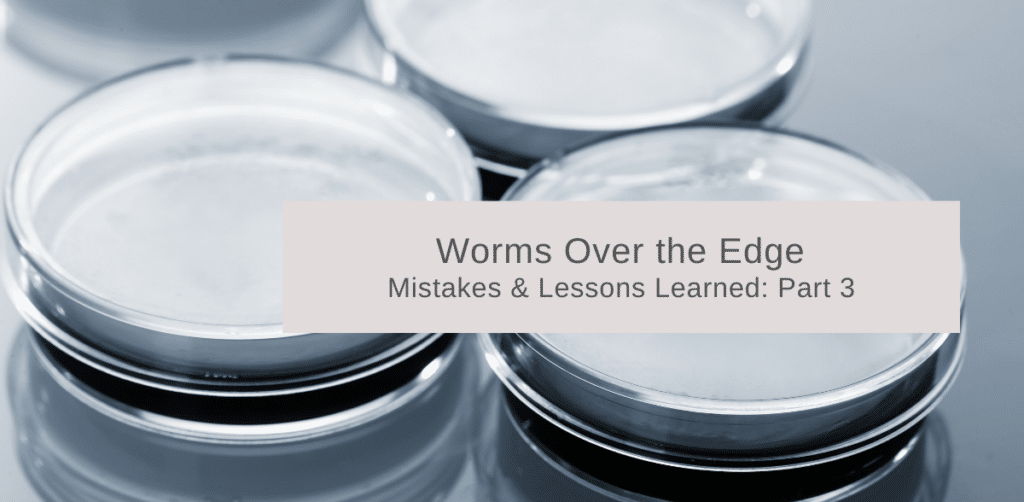Summary:
In this five part series we are exploring some common mishaps when working with C. elegans, so you can hopefully avoid them too! Especially since when testing a specific variable (compound, strain, etc.) we want to limit all other variables that may skew results or lead to inaccurate data. In Part 3, we will discuss the issues that arise with worms burrowing or crawling over the edge of the plate, and ask: I plated 50 worms onto one plate but when I came back the next day, there were only 35. Where did they go?
The most common way of growing C.elegans is on solid nematode growth media (NGM) that has a lawn of OP50 E.coli seeded in the middle of the plate. Not only is this bacteria the food source for your worms, this also helps to keep the worms in one place due to their natural preference to seek out and dwell in areas with high food concentration. In assays where you must keep track of every worm for statistical significance (e.g.lifespan or acute toxicity assays), or after injections where every successful transformation must be recovered, it is paramount to seed the bacterial lawn in the middle of the NGM plate without touching the plastic of the petri dish. Although this is not a 100% fail safe and roughly 50% of worms will crawl off the edge during a lifespan study, this helps to keep those attrition rates constant and predictable.
Some other factors that will encourage worms to burrow are the percentage of agar in their growth media, how starved out the plate is, how densely worms are plated, and the presence of any bubbles or tears in the surface of the agar. The typical concentration of Agar in NGM is 1.75% (17.5g/L); other recipes, for example our high growth media (used for prepping >1 million worms), goes up to 3% agar. This allows us to grow out 50-100K worms per 15cm petri dish and have a high harvest yield. Starvation is another trigger that can cause the worms to burrow because once the lawn of bacteria has been depleted, they exhibit more drastic food seeking behavior and less dwelling, resulting in them crawling down the edge of plates or burrowing holes themselves if the agar is soft enough. A work around we often employ to guarantee we yield enough worms at the end of our experiments (especially if we need to go 5+ days past L4 stage) is to start with twice as many as we want to end up with. We will then often plan for one more technical replicate than we think is needed just incase there is a particular replicate that is having issues or someone drops some of the plates on the floor etc.

Image 1. Example of plate poured with too many bubbles.
Reference
- Stiernagle T. Maintenance of C. elegans. WormBook. 2006 Feb 11:1-11. doi: 10.1895/wormbook.1.101.1. PMID: 18050451; PMCID: PMC4781397
- Yin, D., & Haag, E. S. (2019). Evolution of sex ratio through Gene Loss. Proceedings of the National Academy of Sciences, 116(26), 12919-12924. https://doi.org/10.1073/pnas.1903925116
- Meneely, P. M., Dahlberg, C. L., & Rose, J. K. (2019). Working with worms:caenorhabditis elegans as a model organism. Current Protocols Essential Laboratory Techniques, 19(1). https://doi.org/10.1002/cpet.35
- Stuhr, N.L., Curran, S.P. Bacterial diets differentially alter lifespan and healthspan trajectories in C. elegans. Commun Biol 3, 653 (2020). https://doi.org/10.1038/s42003-020-01379-1
- Kirienko, N. V., Kirienko, D. R., Larkins-Ford, J., Wählby, C., Ruvkun, G., & Ausubel, F. M. (2013). Pseudomonas aeruginosa disrupts Caenorhabditis elegans iron homeostasis, causing a hypoxic response and death. Cell host & microbe, 13(4), 406-416. https://doi.org/10.1016/j.chom.2013.03.003
- Eisenmann, D. M., Wnt signaling (June 25, 2005), WormBook, ed. The C. elegans Research Community, WormBook, doi/10.1895/wormbook.1.7.1, http://www.wormbook.org.
- Wang, H., Zhao, Y., & Zhang, Z. (2019). Age-dependent effects of floxuridine (FUdR) on senescent pathology and mortality in the nematode Caenorhabditis elegans. Biochemical and Biophysical Research Communications. doi:10.1016/j.bbrc.2018.12.161
- Lucanic, M., Plummer, W., Chen, E. et al. Impact of genetic background and experimental reproducibility on identifying chemical compounds with robust longevity effects. Nat Commun 8, 14256 (2017). https://doi.org/10.1038/ncomms14256

